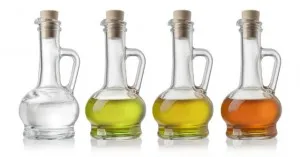Making your own herbal-infused vinegar is easy, and the combination of ingredients you can use is almost endless. All you need is vinegar, and your choice of fresh or dried herbs, a container to store the mixture and basic kitchen utensils.
The vinegar
A high-quality apple cider vinegar like Bragg’s is recommended as ACV offers extensive health benefits including lowering blood sugar and blood pressure, promoting heart health and better digestion in addition to being an effective antimicrobial. If you plan to mostly use it for cooking, a white wine or red wine vinegar can be used. Distilled white vinegar should never be used as it can be derived from petroleum and offers few health benefits.
Herbs
You can use just about any fresh or dried herbs, or a combination of both. Keep in mind that dried herbs impart a stronger, deeper flavor while fresh herbs provide a lighter, more delicate taste. Herbs that are especially nutrient rich such as nettle, dandelion, red clover, red raspberry leaf, yellow dock and chickweed are all great choices, or for primarily culinary use, garlic, rosemary, oregano, thyme, hot peppers, tarragon, dill and basil are popular options.
Vinegar flavored with garlic smells really good and it’s a great herb to combine with others like basil, lemon balm and thyme. To add it, just peel a clove and put it into your jar with your other herbs.
Equipment
You don’t need much in the way of supplies or equipment, but it is essential to remember never to use reactive metal bowls, utensils or containers as vinegar will corrode active metals. Aluminum and copper are known to be the worst. If you plan to store your vinegar in a Mason jar with a metal lid, you’ll need to place a piece of wax paper over the mouth of the jar before capping it.
The only equipment/supplies needed are fairly basic. That includes your ingredients as above, a cutting board and knife, measuring cups, a sterilized container with a lid, bamboo skewer or wooden chopstick, wax paper (if needed as explained above), masking tape and a pen. In order to strain and bottle, you’ll need another sterilized container with a lid, a stainless steel or nylon mesh strainer, a glass bowl, a piece of muslin or cheesecloth, and a new label.
Instructions
Get started by sterilizing your jars, which can be accomplished by using boiling water as you would for canning, or running them through the dishwasher’s wash and dry settings. The ratio for ingredients can vary depending on what you’re looking for, but it is generally 1 cup of dried herbs to 2 cups of vinegar. If you want something with more flavor and/or medicinal properties, use a little more of the herbs.
To begin, add your herbs to the jar followed by the vinegar. You may want to gently heat your vinegar before pouring it in to facilitate extraction. As dried herbs tend to float, you’ll need your skewer or chopstick to submerge the herbs in order to get them completely soaked so all trapped air bubbles are released.
Cap the jar, placing the wax paper over the mouth first if using a metal lid, and label it using masking tape and a pen like a sharpie. Be sure to include the name of the preparation, the ingredients, the date it was made and the date it will be ready. Store the jar in an area out of direct light.

Allow the mixture to ‘stew’ for 2 to 4 weeks before straining and storing. For straining, use a clean piece of muslin fabric inside of a stainless steel mesh strainer. Be sure to squeeze or press out as much of the liquid as possible from the herb.
If you’ve never made, or even tasted, an herbal-infused vinegar you may want to start with the small batch by halving the recipe to fit a half-pint jar first. If it turns out well and you like it, then you can make a full-sized batch the next time. Enjoy!
-The Alternative Daily
Sources:
http://redfernfarms.com/making-herb-infused-vinegars
http://www.motherearthnews.com/homesteading-and-livestock/how-to-make-herb-vinegar-
